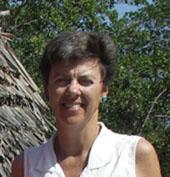Monica Udvardy
B.A. University of California at Davis 1976;
M.A. University of California at Santa Barbara 1981;
Ph.D. Uppsala University, Sweden 1990
Global South Rural Societies; Sub-Saharan Africa, East Africa, Kenya, Tanzani
My research interests have dual foci: (1) My current, on-going research centers on the contextually changing meanings of tangible and intangible cultural property, as well as cultural identity politics and anthropological ethics. With my collaborators, I am exposing the global traffic in a category of non-Western art/artifacts (described below) as a case study; and (2) for over twenty years, my long-standing research has examined expressions of gender and gender theory approached from both anthropology of meaning and from development anthropology perspectives.
My current advocacy anthropology research project, in which I am collaborating with anthropologist Dr. Linda Giles and Kenyan museum curator, Mr. John Mitsanze, tracks the trajectories and changing meanings of vigango (pl., kigango, sing.). Erected by the Mijikenda peoples of the Kenyan coastal hinterland, vigango are wooden memorial statues believed to incarnate the spirit of deceased males who were members during their lives of the secret society, Gohu. The on-going theft of these statues to supply the world art market has disrupted Mijikenda families, their religious beliefs, and intergenerational relations. In the United States, many of the almost 400 vigango we have so far located were purchased by members of the Hollywood entertainment industry and subsequently donated to museums, in some cases in order to create charitable tax deductions for the donors. Literally hundreds of vigango are now stored in United States museums, where they bolster African art collection, and have even been used as film props. These changing uses and meanings of Mijikenda memorial statues as they are propelled around the world illustrate the theoretical, political economic, and ethical issues surrounding the global traffic in cultural property, which Interpol in 2006 estimated to be a $4.5 billion annual industry.
Simultaneously, I continue to write and publish my research on aspects of gender relations among the Mijikenda peoples of the East African coast and hinterland. To date, my theoretical work has focused on the intersection of gender with such topics as aging and the lifecourse, indigenous notions of gendered property rights, kinship, ritual, ethnomedicine and medicocosmology, secret societies, ethnicity and the body. I also retain my strong interest in gender issues in developments, where my research among the Mijikenda has focused on women's organizing and development as ideology, the impact of women's groups on individual women's variable economic successes, and Mijikenda women's groups practical and strategic gender interests.
More about Dr. Udvardy's research and recent events concerning vigango is available in the considerable news coverage of recent events. See, inter alia,
(Note: Web links below are not maintained by the University of Kentucky. The University takes no responsibility for the content of these sites.)
Monica Udvardy, Linda L. Giles, and John B. Mitsanze. (2003) The Transatlantic Trade in African Ancestors: Mijikenda Memorial Statues (Vigango) and the Ethics of Collecting and Curating Non-Western Cultural Property. American Anthropologist 105(3):566-580. Abstract
Kenya statues report, PRI's The World, September 15, 2006.
UK anthropologist helps right a wrong in Kenya, Lexington Herald-Leader, September, 14, 2006.
Kenya Seeks to Recover, Protect Memorial Statues, NPR's All Things Considered, April 23, 2006.
The Case of the Stolen Statues: Solving a Kenyan Mystery, The New York Times, April 16, 2006.
- Third World Rural Societies; Sociocultural Anthropology; Gender; Cultural Property Issues
- theoretical and advocacy approaches to cultural property
- global traffic in non-Western cultural property
- expressions of gender in culture and society
- cultural identity politics and anthropological ethics
- ideology, symbolism and social organization
- non-Western women's organizations
- studies of the lifecourse, especially aging
- ethnomedical belief systems
Courses Regularly Taught
Graduate seminars:
- ANT 773: Advanced Seminar in Symbols and Meaning
- ANT 737: Sociocultural Theories in the Anthropology of Gender
Upper-division undergraduate courses:
- ANT 550: Symbols and Culture
- ANT 433: Social Organization
- ANT 401/Women's Studies 416: Gender Roles in Cross-Cultural Perspective
Lower-division undergraduate courses:
- HONORS 101D: Introduction to Honors in the Social Sciences: The Self and Others
- ANT 220: Introduction to Cultural Anthropology
- ANT 160: Cultural Diversity in the Modern World
- 2004 Cultural Property as Global Commodities. The Case of Mijikenda Memorial Statues. Cultural Survival Quarterly Winter:78-82 (with Linda L. Giles and John B. Mitsanze).
- 2003 The Transatlantic Trade in African Ancestors: Mijikenda Memorial Statues (Vigango) and the Ethics of Collecting and Curating Non-Western Cultural Property. American Anthropologist 105(3):566-580 (with Linda L. Giles and John B. Mitsanze).
- 1998 Theorizing Past and Present Women's Organizations in Kenya. World Development 26(9):1749-1761.
- 1995 Property, Personhood and Self: Provisional Women and Enduring Men among the Giriama of Kenya. Research in Economic Anthropology 16:325-348.
- 1992 Gender, Aging and Power in Sub-Saharan Africa: Challenges and Puzzles. Journal of Cross-Cultural Gerontology 7(4):275-289 (with Maria Cattell).
- 1992 Special issue on "Gender, Aging and Power." Journal of Cross-Cultural Gerontology 7(4):275-429. (Guest Co-editor with Maria Cattell.)
- 1992 The Fertility of the Post-Fertile. Concepts of Gender, Aging and Reproductive Health among the Giriama of Kenya. Journal of Cross-Cultural Gerontology 7(4):289-307.



